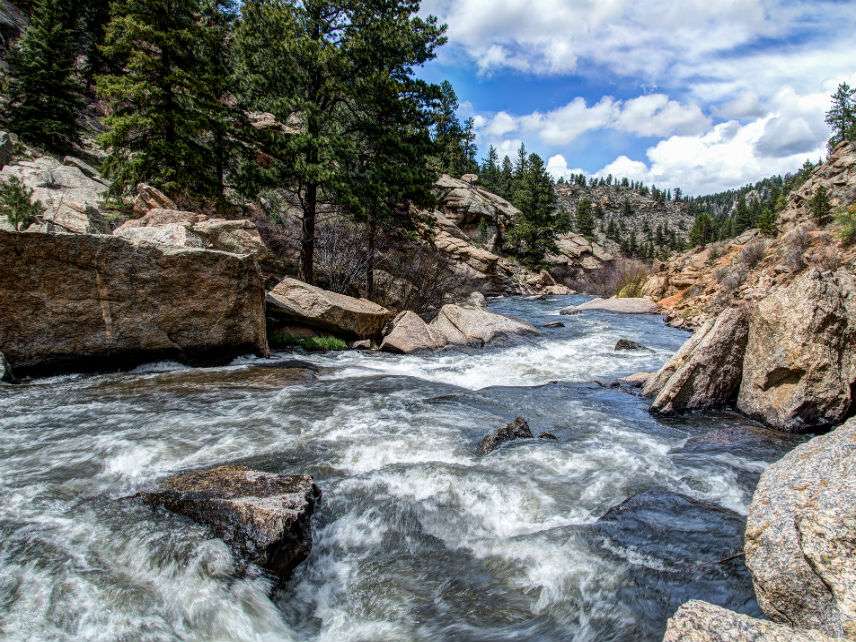Does the Colorado River Have Rights?
The river doesn't need rights if people have strong property rights to its water.

"In a first-in-the-nation lawsuit filed in federal court, the Colorado River is asking for judicial recognition of itself as a 'person,' with rights of its own to exist and flourish." So declares a press release from the activist organization Deep Green Resistance. The lawsuit against Colorado's governor is being filed in federal district court by the Community Environmental Legal Defense Fund (CELDF), which says it "seeks a ruling that the Colorado River, and its ecosystem, possess certain rights, including the right to exist, flourish, evolve, regenerate, and restoration."
In support of the legal theory that rivers have rights, the suit cites Supreme Court Justice William Douglas' famous dissent in Sierra Club v. Morton (1972). In that case, the Sierra Club sued to block the Disney company from building a ski resort at Mineral King in the Sequoia National Forest. The majority of the court ruled that the Sierra Club did not have legal standing—that is, that the group failed to demonstrate to the court sufficient connection to and harm from the law or action challenged to support that party's participation in the case. (As it happens, the ski resort was never built anyway.)
In his dissent, Justice Douglas, with considerable legal poetry, argued:
Inanimate objects are sometimes parties in litigation. A ship has a legal personality, a fiction found useful for maritime purposes. The corporation sole—a creature of ecclesiastical law—is an acceptable adversary and large fortunes ride on its cases. The ordinary corporation is a "person" for purposes of the adjudicatory processes, whether it represents proprietary, spiritual, aesthetic, or charitable causes.
So it should be as respects valleys, alpine meadows, rivers, lakes, estuaries, beaches, ridges, groves of trees, swampland, or even air that feels the destructive pressures of modern technology and modern life. The river, for example, is the living symbol of all the life it sustains or nourishes—fish, aquatic insects, water ouzels, otter, fisher, deer, elk, bear, and all other animals, including man, who are dependent on it or who enjoy it for its sight, its sound, or its life. The river as plaintiff speaks for the ecological unit of life that is part of it. Those people who have a meaningful relation to that body of water—whether it be a fisherman, a canoeist, a zoologist, or a logger—must be able to speak for the values which the river represents and which are threatened with destruction.
The CELDF also cites a recently enacted provision in the constitution of Ecuador that confers rights on nature:
Nature, or Pachamama, where life is reproduced and occurs, has the right to integral respect for its existence and for the maintenance and regeneration of its life cycles, structure, functions and evolutionary processes. All persons, communities, peoples and nations can call upon public authorities to enforce the rights of nature.
Let's just say that the law pertaining to the use of water is complex. I personally prefer common law riparian rights as a way to govern streams, rivers, and lakes. Riparian water rights give landowners along a stream rights to an undiminished quantity and quality of water. Consider the 1913 case Whalen v. Union Bag & Paper, in which a New York Court of Appeals ruled that a million-dollar paper mill employing 500 people did not have the right to pollute the water flowing past Robert Whalen's 255-acre farm on Kayaderosseras Creek, near Albany, New York. The Court reasoned:
Although the damage to the [farmer] may be slight as compared with the [paper mill's] expense of abating the condition, that is not a good reason for refusing an injunction. Neither courts of equity nor law can be guided by such a rule, for if followed to its logical conclusion it would deprive the poor litigant of his little property by giving it to those already rich.
It did not matter how much money had been invested or how many jobs were at stake; the paper company had violated Whalen's right to an undiminished quantity and quality of water flowing past his farm.
In the western United States, the prior appropriation doctrine awarded water rights to individuals on a "first-in-time, first-in-right" basis. Those who first diverted water had first claim on water. State water laws also typically require that rightsholders divert water for use; otherwise, they forfeit it to other users. (In other words, use it or lose it.) Thus state intervention basically stymied the development of water markets that would enable farmers, cities, ranchers, fishers, canoeists, and environmentalists to bargain among themselves on the best ways to manage rivers and streams. The Property Environment Research Center* in Bozeman, Montana, describes how markets enable the nonprofit Scott River Trust in Siskiyou County, California, to lease water from rightsholders in order to maintain instream flows to support salmon runs. There is no need to confer rights on the Scott River when trading transferable rights to water make it possible to protect salmon.
Deep Green Resistance and CELDF have a point in that unowned natural goods are subject to a tragedy of the commons, in which users have an incentive to overexploit and ruin them. But instead of trying to confer rights on nature, the better course is to assign strong property rights to people, so that individual and common owners are empowered to protect resources and environmental amenities.
*Disclosure: I have been the happy beneficiary of grants, conferences, and intellectual enrichment from PERC for many years.




Show Comments (55)